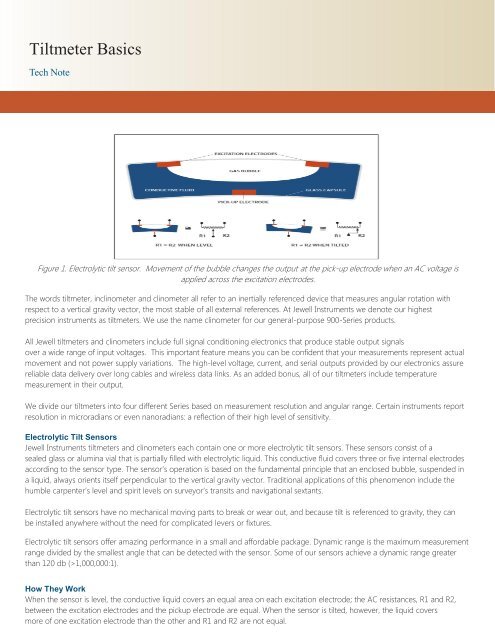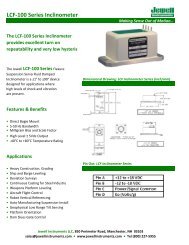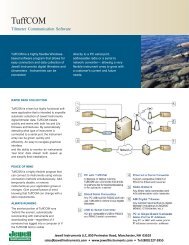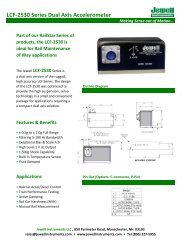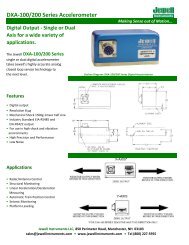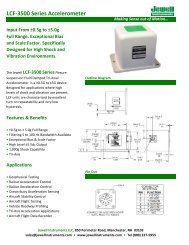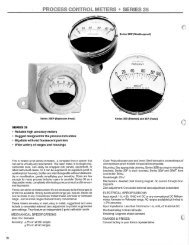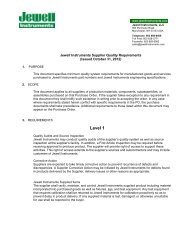Tiltmeter Basics - Jewell Instruments
Tiltmeter Basics - Jewell Instruments
Tiltmeter Basics - Jewell Instruments
Create successful ePaper yourself
Turn your PDF publications into a flip-book with our unique Google optimized e-Paper software.
<strong>Tiltmeter</strong> <strong>Basics</strong>Tech NoteFigure 1. Electrolytic tilt sensor. Movement of the bubble changes the output at the pick-up electrode when an AC voltage isapplied across the excitation electrodes.The words tiltmeter, inclinometer and clinometer all refer to an inertially referenced device that measures angular rotation withrespect to a vertical gravity vector, the most stable of all external references. At <strong>Jewell</strong> <strong>Instruments</strong> we denote our highestprecision instruments as tiltmeters. We use the name clinometer for our general-purpose 900-Series products.All <strong>Jewell</strong> tiltmeters and clinometers include full signal conditioning electronics that produce stable output signalsover a wide range of input voltages. This important feature means you can be confident that your measurements represent actualmovement and not power supply variations. The high-level voltage, current, and serial outputs provided by our electronics assurereliable data delivery over long cables and wireless data links. As an added bonus, all of our tiltmeters include temperaturemeasurement in their output.We divide our tiltmeters into four different Series based on measurement resolution and angular range. Certain instruments reportresolution in microradians or even nanoradians: a reflection of their high level of sensitivity.Electrolytic Tilt Sensors<strong>Jewell</strong> <strong>Instruments</strong> tiltmeters and clinometers each contain one or more electrolytic tilt sensors. These sensors consist of asealed glass or alumina vial that is partially filled with electrolytic liquid. This conductive fluid covers three or five internal electrodesaccording to the sensor type. The sensor’s operation is based on the fundamental principle that an enclosed bubble, suspended ina liquid, always orients itself perpendicular to the vertical gravity vector. Traditional applications of this phenomenon include thehumble carpenter’s level and spirit levels on surveyor’s transits and navigational sextants.Electrolytic tilt sensors have no mechanical moving parts to break or wear out, and because tilt is referenced to gravity, they canbe installed anywhere without the need for complicated levers or fixtures.Electrolytic tilt sensors offer amazing performance in a small and affordable package. Dynamic range is the maximum measurementrange divided by the smallest angle that can be detected with the sensor. Some of our sensors achieve a dynamic range greaterthan 120 db (>1,000,000:1).How They WorkWhen the sensor is level, the conductive liquid covers an equal area on each excitation electrode; the AC resistances, R1 and R2,between the excitation electrodes and the pickup electrode are equal. When the sensor is tilted, however, the liquid coversmore of one excitation electrode than the other and R1 and R2 are not equal.
How They’re Used in the <strong>Tiltmeter</strong><strong>Jewell</strong> Instuments tiltmeters operate electrolytic tilt sensors as AC voltage dividers (potentiometers). The tiltmeter’s electroniccircuitry creates a balanced AC signal that is applied differentially to the two excitation electrodes. The amplitude and phase of theoutput signal, measured at the pickup electrode, indicate the magnitude and direction of tilt movement.Tilt sensors can also be operated as the active half of a Wheatstone bridge. The Wheatstone bridge circuit is mainly used for nulling(leveling) applications. Regardless of which type of circuit is used, only AC excitation may be applied to the sensor. Direct currentdamages the sensor by causing plating of the electrodes.Our uniaxial tiltmeters use a single tilt sensor. Biaxial tiltmeters in our 500, 700 and 800-Series use two tilt sensors, orientedorthogonally. Our 900-Series biaxial clinometers use an electrolytic tilt sensor with five electrodes, arranged in the pattern of a cross.In this instance, biaxial tilt measurements are made by alternately exciting orthogonal pairs of electrodes.<strong>Jewell</strong> <strong>Instruments</strong> LLC, 850 Perimeter Road, Manchester, NH 03103sales@jewellinstruments.com • www.jewellinstruments.com • Tel (800) 227-5955


